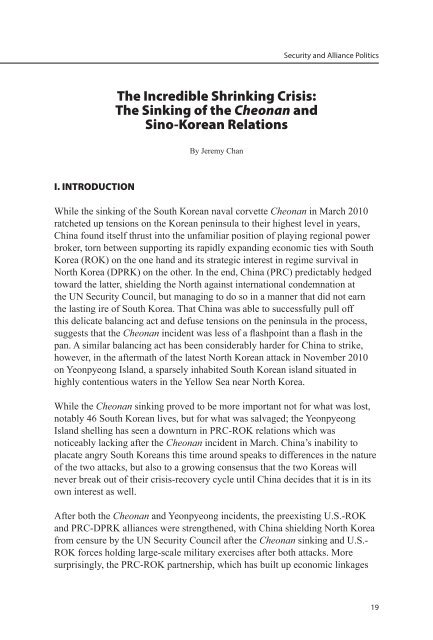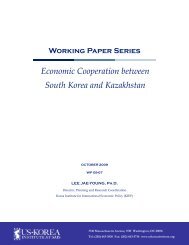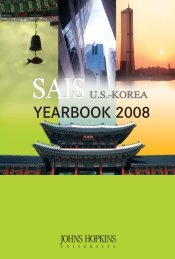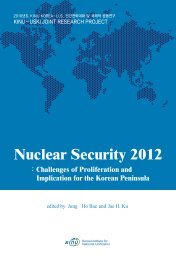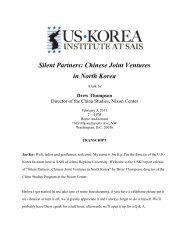The Incredible Shrinking Crisis - US-Korea Institute at SAIS
The Incredible Shrinking Crisis - US-Korea Institute at SAIS
The Incredible Shrinking Crisis - US-Korea Institute at SAIS
You also want an ePaper? Increase the reach of your titles
YUMPU automatically turns print PDFs into web optimized ePapers that Google loves.
Security and Alliance Politics<br />
<strong>The</strong> <strong>Incredible</strong> <strong>Shrinking</strong> <strong>Crisis</strong>:<br />
<strong>The</strong> Sinking of the Cheonan and<br />
Sino-<strong>Korea</strong>n Rel<strong>at</strong>ions<br />
By Jeremy Chan<br />
I. INTRODUCTION<br />
While the sinking of the South <strong>Korea</strong>n naval corvette Cheonan in March 2010<br />
r<strong>at</strong>cheted up tensions on the <strong>Korea</strong>n peninsula to their highest level in years,<br />
China found itself thrust into the unfamiliar position of playing regional power<br />
broker, torn between supporting its rapidly expanding economic ties with South<br />
<strong>Korea</strong> (ROK) on the one hand and its str<strong>at</strong>egic interest in regime survival in<br />
North <strong>Korea</strong> (DPRK) on the other. In the end, China (PRC) predictably hedged<br />
toward the l<strong>at</strong>ter, shielding the North against intern<strong>at</strong>ional condemn<strong>at</strong>ion <strong>at</strong><br />
the UN Security Council, but managing to do so in a manner th<strong>at</strong> did not earn<br />
the lasting ire of South <strong>Korea</strong>. Th<strong>at</strong> China was able to successfully pull off<br />
this delic<strong>at</strong>e balancing act and defuse tensions on the peninsula in the process,<br />
suggests th<strong>at</strong> the Cheonan<br />
pan. A similar balancing act has been considerably harder for China to strike,<br />
however, in the afterm<strong>at</strong>h of the l<strong>at</strong>est North <strong>Korea</strong>n <strong>at</strong>tack in November 2010<br />
on Yeonpyeong Island, a sparsely inhabited South <strong>Korea</strong>n island situ<strong>at</strong>ed in<br />
highly contentious w<strong>at</strong>ers in the Yellow Sea near North <strong>Korea</strong>.<br />
While the Cheonan sinking proved to be more important not for wh<strong>at</strong> was lost,<br />
notably 46 South <strong>Korea</strong>n lives, but for wh<strong>at</strong> was salvaged; the Yeonpyeong<br />
Island shelling has seen a downturn in PRC-ROK rel<strong>at</strong>ions which was<br />
noticeably lacking after the Cheonan incident in March. China’s inability to<br />
plac<strong>at</strong>e angry South <strong>Korea</strong>ns this time around speaks to differences in the n<strong>at</strong>ure<br />
of the two <strong>at</strong>tacks, but also to a growing consensus th<strong>at</strong> the two <strong>Korea</strong>s will<br />
never break out of their crisis-recovery cycle until China decides th<strong>at</strong> it is in its<br />
own interest as well.<br />
After both the Cheonan and Yeonpyeong incidents, the preexisting U.S.-ROK<br />
and PRC-DPRK alliances were strengthened, with China shielding North <strong>Korea</strong><br />
from censure by the UN Security Council after the Cheonan sinking and U.S.-<br />
ROK forces holding large-scale military exercises after both <strong>at</strong>tacks. More<br />
surprisingly, the PRC-ROK partnership, which has built up economic linkages<br />
19


